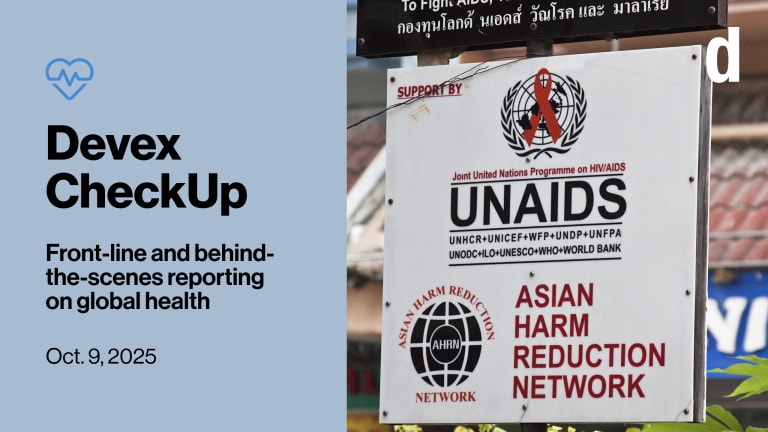
Next week, health leaders from around the world will descend on Geneva for the annual World Health Organization executive board meeting. With WHO’s new leader, Dr. Tedros, committed to steering the organization in a new direction, the meeting provides a bellwether for how dynamic the organization will be in tackling the global health challenges in the next five years.
Here are five things to watch out for on the agenda.
1. Access to medicine
If there is one issue that ignites the media, it’s how much prices for new— and old — medicines are soaring. From the exponential rise in the cost of an EpiPen, which led to accusations of “racketeering,” to a new therapy for blindness with a staggering price tag of $850,000, rich and poor countries are now both struggling to pay for medicines.
Access is only half of the problem, with almost no research and development being directed to conditions affecting the poor, rare diseases or discovering new antibiotics. With estimates suggesting 10 million people will die every year by 2050 from antibiotic resistance, action must quickly follow words. Driving innovation — especially where this is no market incentive — as well as ensuring access to new health technologies is a key challenge to be addressed.
Recommendations from the United Nations Secretary-General’s High-Level Panel on Access to Medicine will at last be discussed — these include everything from a plan to reduce the cost of new medecines by driving a transparency revolution in R&D and pricing, to new incentives for innovation for those groups that invest in and discover new antibiotics.
2. Noncommunicable diseases
The biggest drivers of death and disability across the globe include everything from cervical cancer, to mental health, to obesity, which is now being viewed as a gateway disease to a plethora of cancers, as well as diabetes and heart disease. Almost all NCDs are on the rise, which is why a new global independent commission, co-chaired by Pakistan’s Dr. Sania Nishtar and President Tabaré Vázquez of Uruguay, has been launched to spur action around the world.
There has been sporadic progress; Mexico introduced a soda tax that has led to reduced consumption and shows how countries can make progress in fighting obesity, especially amongst children. Australia has dramatically cut cervical and related oral cancers by vaccinating both girls and boys, and mental health is increasingly being talked about and treated as a critical cross-cutting issue. These efforts will need to be scaled up dramatically in order to curb the rise in NCDs, which threaten to collapse already fragile health systems.
3. Polio transition
One of the great public health stories of our time seems to be in its final chapter. With only 21 cases of the disease detected in just two countries last year, it seems the end is finally nigh.
However, it’s not all good news. As well as the fact that the disease continues to cling on in some of the most difficult places in the world, there is the small problem of how to wind up a programme that underwrites much of the public health workforce of low and middle-income countries.
The Global Polio Eradication Initiative is winding down. What are the risks?
As global polio programs enter the final stages of eradication activities, with certification expected in the next three years, the Global Polio Eradication Initiative is beginning the process of winding down its activities and will eventually cease to exist. But a new report from RESULTS is warning about the gap this will leave.
The polio infrastructure has laid the foundation for global disease surveillance and developed a cadre of largely female health workers that are close to achieving what many once dismissed as impossible. In countries like India, which saw its last cases seven years ago, the infrastructure is being repurposed to tackle other child killers like diarrhea and pneumonia. National leadership, as shown in India will be key to ensuring a great polio legacy.
4. Tuberculosis
Tuberculosis has long been in the shadow of HIV, having received exponentially less funds, which has inevitably led to a lack of headway in terms of developing new TB diagnostics and medicines. That’s not the only challenge; growing drug resistance is making the disease more difficult and costly to manage.
And with many TB patients in low- and middle-income countries seeking treatment in the unregulated private sector, where patients are regularly misdiagnosed and put on the wrong TB therapy, it is important to design programs that fit the national landscape. With a High-Level Meeting on tuberculosis due to take place around the U.N. General Assembly in September, this could be a make or break year for tackling the disease.
5. Snakebites
Snakebites tend to affect poor rural communities, which is one of the reasons they get so little attention. It is estimated that of the 5.4 million snakebites that happen every year, more than 80,00 people die and 400,000 face permanent disabilities, including blindness and amputation.
It’s also a major financial burden with the antivenom costing approximately $125 in sub-Saharan Africa and as much as $5,150 in India. These high costs often lead to additional consequences, including children being removed from school due to an inability to pay fees, or being forced to sell off farmland to cover the health debt. WHO’s recent addition of snakebite to the list of neglected tropical diseases is a step in the right direction, but unless the cost of the antivenom is reduced, progress will be limited.









